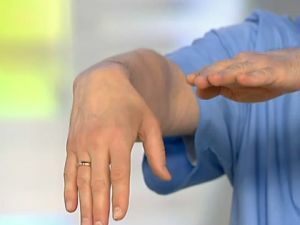 The plergy is a condition of the patient, which is characterized by paralysis of individual muscle groups or all completely. Quite often it is a syndrome that occurs due to neurological disorders.
The plergy is a condition of the patient, which is characterized by paralysis of individual muscle groups or all completely. Quite often it is a syndrome that occurs due to neurological disorders.
As a rule, plethy affects different muscle groups.
The disorder is classified by the number of affected limbs:
- mono plegia is a violation of the motor function of a single limb;
- pair plegy - two: upper or lower;
- gemi a plague is a violation of the motor function of the two limbs from either side;
- in the event that the violation occurred simultaneously on the hands and feet, then in this case this disease is called tetra plge.
Contents
- Acute punching on the limb
- Neurological disorders with monoplegia
- Defeat of the upper limb
- Femoral monoplegia
- How is it manifested?
- Diagnosis and therapies
- Draw conclusions
Point strike on the extremity of
Very often monoplegia occurs in such cases:
- in focal brain diseases;
- with hysteria;
- for serious injuries to the limbs;
- for spinal problems.
Monoplegia is characterized by muscle atrophy, atony, areflexia, muscle hypertension and pathological reflexes.
During the examination of the patient, a true disease is established by the physicians, depending on what exactly he has complaints of weakness in the limbs, as well as the concomitant symptomatology.
In very rare cases, the patient complains of weakness at the same time in four limbs. However, this may be a consequence of the defeat of a particular muscle group.

Neurological disorders with monoplegia
Quite often prolonged immobility of arms and legs can lead to serious problems with human health. In the case of monoplegia, muscle atrophy is not very pronounced, as with other types of paralysis.
Tendon reflexes in this case also do not change. During electrical stimulation, the muscle response shows that there has not been a big change in the body.
Very often the cause of monoplegia is precisely the damage to the cerebral cortex. Also, the provoking factor may be a brain tumor, cerebral vascular lesions and severe head injuries caused by a different route. 
Weakness in one limb can develop due to multiple sclerosis and a spinal tumor in the event that the disease is in its early stages.
Weakness, which appears due to damage to the cortico-spinal pathways, is accompanied by increased reflexes and Babinsky's symptom. If the damage is serious, then with acute lesions, spinal shock and a decrease in reflexes can occur.
Acute lesions can lead to the fact that the intensity of reflexes will decrease, and in especially severe cases can lead to their loss. In this situation, after the first signs of monoplegia, muscle atrophy can occur within two weeks.
Lesion of upper limb
Shoulder atrophic monoplegia, which affects the hands, is a rare disease. It often occurs as a result of shoulder injuries in early childhood, with poliomyelitis or syringomyelia.
Femurine monoplegia
 Monoplegia of the lower limb is more common. This syndrome is caused by the lesion of the lumbar spinal cord.
Monoplegia of the lower limb is more common. This syndrome is caused by the lesion of the lumbar spinal cord.
Disorders are due to myelitis, severe injuries, and tumors of the spinal cord.
Paralysis in such cases begins with one limb, and later, more often, spreads further.
Paralysis of the lower limb can be caused by squeezing the lumbosacral plexus tumor.
How is it manifested?
Symptoms of monoplegia are:
- impaired sensitivity;
- visual field defects;
- aphasia;
- violation of pain sensitivity on the opposite side of the lesion.
Some varieties of paralysis are distinguished as a separate disease. Among other diseases characterized by immobilization of one limb, poliomyelitis, cerebral palsy and diseases, which are transmitted to children from their parents.
Diagnosis and therapy methods
Diagnosis in monoplegia includes such items: examination by a neurologist. In addition, reflex testing is performed,  diagnostics using magnetic resonance imaging, computed tomography and fluoroscopy.
diagnostics using magnetic resonance imaging, computed tomography and fluoroscopy.
As a rule, all diagnostics in case of paralysis of the motor functions of the body are performed on the basis of medical indications.
Diagnosis of monoplegia involves checking the operation of the limbs, the nature of how they cope with different procedures. In addition, such a diagnosis allows you to determine the disease itself and choose doctors that methods of treatment that are best for the patient and will improve his condition.
The main task in the treatment is the elimination of the causes and diseases caused by monoplegia. After the diagnosis is established, the first thing to do is a special massage and gymnastics, which allows to restore the motor functions.
For each situation, a special treatment program is chosen by therapists, which includes the use of effective medications, physiotherapy and, if necessary, surgical intervention.
The doctor selects the appropriate drug therapy on an individual basis. Very often, for intake can be prescribed Proseril and vitamin B1.
An effective method of therapy is exercise therapy. Initially, lighter movements are used, with initial successes you can gradually increase the load. Effective combination of exercise therapy with water procedures.
In addition, doctors prescribe electrotherapy. It is worth remembering that when paralysis, you need to move as much as possible. If the patient himself can not do this, then it is necessary to help him and develop the muscles of the arm or leg, which stopped working.
Making conclusions
Monoplegia is a serious disease that affects one limb. The disorder can be acquired, due to serious head injuries, spinal cord and various infectious diseases, or be inherited.
The earlier a patient turns to a doctor, the more likely it is to successfully combat the violation.



